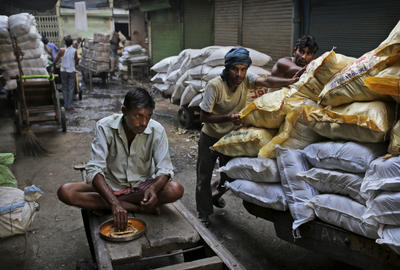Undershooting, however, implies a reversion to fundamentals — and a better future performance.
Inflation was due to multiple cost shocks sustained in 2011 due to delayed rains, global liquidity driving up oil prices despite lower global net demand and capital outflows and a depreciation of the rupee due to euro zone problems. Sustained high food inflation since 2007, and its spill-over into general inflation, is forcing some action to improve productivity and marketing in agriculture. This is a thorny issue because here, as in labour laws, the states are involved. But a promising strategy would be for the central government to pass enabling legislation to kick start competition and convergence among the states. If one does well the others will not want to be left behind. FDI in retail will function as an agent of change. As the numbers of those who gain from better market integration rise, so will pressures to relax restrictions, setting in motion a virtuous cycle. Renewed vigour on reform shows that action is possible even in a minority coalition.
As supply-side action from the government and an output gap softens inflation, the Reserve Bank of India has room to reduce interest rates to levels that will encourage investment and consumer durable spending, but also give a positive return to savers. This is timely because five years have passed since peak investment rates. So overcapacity built during the boom years of the mid-2000s may have dissipated sufficiently to make room for a new round of investment. The global export slowdown is a risk, but diversification of the export basket is a promising strategy that has worked for India in the past.
The government stimulus geared toward consumption transfers to the poor created demand for diversified types of food that now dominate the average consumption basket. But restrictions in agricultural marketing and food retail that preserve patronage structures have kept the supply response inadequate, even over the longer run. Government food grain stocks were ineffectively used since the food price spikes in 2007, but cannot restrain price rises in non-cereal food items in any case. Rising food inflation, aspirations and employment assurance schemes triggered large hikes in average wages, which in turn pushed up prices. Nominal wages tended to overcorrect and then slow down. Moreover, some rise in India’s productivity meant the wage rise could have been absorbed in the absence of other cost shocks.
India’s manufacturing growth collapsed, implying that despite a high fiscal and current account deficit there was no generalised excess demand. Only some commodities, where rigidities prevented either an expansion in supply, or a contraction in demand, had excess demand. Meanwhile, an outflow-driven depreciation of the rupee kept the cost of imports high. Inelastic demand for oil, in the absence of local price pass-through, and for gold, in the absence of other inflation hedges, explained India’s current account deficit in 2012. Since supply-side changes are driving it, the current softening of international oil prices may persist. This will help decrease India’s current account deficit. More domestic pass-through of oil prices will also reduce oil imports and the current account deficit. The fear of a downgrade is forcing action to reduce the fiscal deficit.
A country of over one billion people undergoing rapid catch-up growth requires a lot of infrastructure; China built its infrastructure in the late 1990s. India was expected to avoid the global slowdown on the basis of a strong infrastructure cycle. But, instead, holdups throughout the country slowed overall growth. The Twelfth Five-Year Plan’s target of US$1 trillion infrastructure spending requires around half to come from the private sector. The private sector has contributed a rising share, and the government’s targets for it were actually exceeded through the boom years. But investment collapsed below target in 2009–10. The cause was policy inconsistency and delays in government clearance. The scale of investment exceeded government capacity. However, the government is now setting up a national board to facilitate large projects, and asking cash-rich public sector undertakings to invest.
Judicial activism in response to executive ineptness contributed to the corruption hype throughout the year. But recent events suggest the judiciary’s response was an overreaction. The Supreme Court has now clarified that the allocation of natural resources is a policy decision and therefore a prerogative of the executive, but courts can intervene if an allocation lacks ‘fairness and non-arbitrariness’. Thus, institutions are slowly finding appropriate responses to new challenges.
Catch-up growth is normally faster than industrial-country growth but it only defines a potential or trend growth rate. Compared to China’s performance, India’s catch-up growth has been volatile. But institutional strengthening may make growth more robust in the coming years.
Ashima Goyal is Professor of Economics at the Indira Gandhi Institute of Development Research, Mumbai.
This is part of a special feature on 2012 in review and the year ahead.

